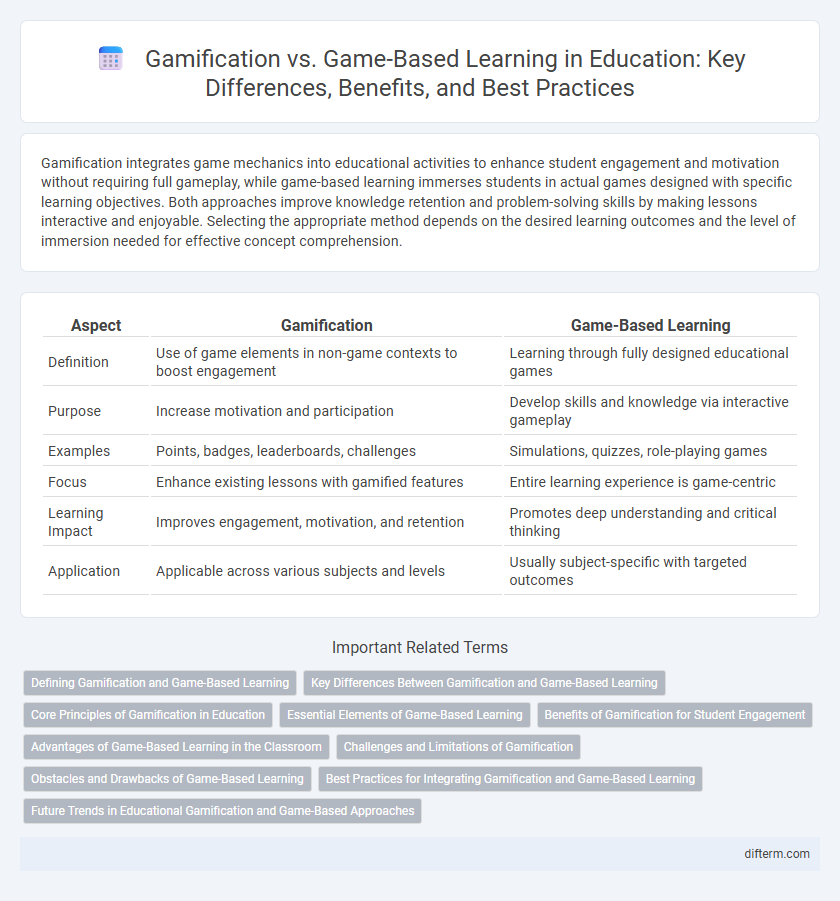Gamification integrates game mechanics into educational activities to enhance student engagement and motivation without requiring full gameplay, while game-based learning immerses students in actual games designed with specific learning objectives. Both approaches improve knowledge retention and problem-solving skills by making lessons interactive and enjoyable. Selecting the appropriate method depends on the desired learning outcomes and the level of immersion needed for effective concept comprehension.
Table of Comparison
| Aspect | Gamification | Game-Based Learning |
|---|---|---|
| Definition | Use of game elements in non-game contexts to boost engagement | Learning through fully designed educational games |
| Purpose | Increase motivation and participation | Develop skills and knowledge via interactive gameplay |
| Examples | Points, badges, leaderboards, challenges | Simulations, quizzes, role-playing games |
| Focus | Enhance existing lessons with gamified features | Entire learning experience is game-centric |
| Learning Impact | Improves engagement, motivation, and retention | Promotes deep understanding and critical thinking |
| Application | Applicable across various subjects and levels | Usually subject-specific with targeted outcomes |
Defining Gamification and Game-Based Learning
Gamification integrates game elements such as points, badges, and leaderboards into non-game educational contexts to increase student engagement and motivation. Game-based learning uses actual games designed with educational objectives to immerse learners in interactive, problem-solving experiences. Both strategies enhance learning outcomes but differ fundamentally in their approach and implementation within educational environments.
Key Differences Between Gamification and Game-Based Learning
Gamification integrates game elements such as points, badges, and leaderboards into traditional educational activities to boost motivation and engagement. Game-based learning involves using fully designed games specifically created to achieve learning objectives through immersive experiences and problem-solving tasks. Unlike gamification, game-based learning centers on active gameplay that simulates real-world scenarios, promoting deeper understanding and skill development.
Core Principles of Gamification in Education
Core principles of gamification in education include the use of point systems, leaderboards, and badges to motivate students by tapping into intrinsic and extrinsic rewards. Engagement is enhanced through clear goals, immediate feedback, and progressive challenges that stimulate competition and collaboration. Incorporating narrative elements and adaptive learning paths fosters deeper involvement and improves retention rates in diverse educational settings.
Essential Elements of Game-Based Learning
Game-based learning incorporates essential elements such as clear objectives, immediate feedback, and adaptive challenges to enhance student engagement and knowledge retention. It integrates narrative, rules, and rewards to create immersive experiences that promote critical thinking and problem-solving skills. Unlike general gamification, game-based learning relies on structured gameplay to facilitate deeper cognitive connections and motivation in educational settings.
Benefits of Gamification for Student Engagement
Gamification enhances student engagement by integrating game mechanics such as points, badges, and leaderboards into educational content, motivating learners through instant feedback and competitive elements. This approach promotes active participation and sustained interest, leading to improved knowledge retention and skill development. Gamification also supports personalized learning experiences, allowing students to progress at their own pace while fostering collaboration and problem-solving skills.
Advantages of Game-Based Learning in the Classroom
Game-based learning enhances student engagement by integrating educational content into interactive video games, promoting deeper understanding through immersive experiences. This approach fosters critical thinking and problem-solving skills by presenting real-world challenges within a controlled virtual environment. Research indicates that students using game-based learning show increased motivation and improved retention compared to traditional teaching methods.
Challenges and Limitations of Gamification
Gamification in education faces challenges such as maintaining long-term student engagement and avoiding extrinsic motivation overshadowing intrinsic learning goals. Limitations include the risk of oversimplifying complex subjects and the potential for unequal access to technology, which can hinder the effectiveness of gamified learning environments. Educators must carefully design gamification strategies to balance entertainment with educational value and ensure inclusivity.
Obstacles and Drawbacks of Game-Based Learning
Game-based learning faces obstacles such as high development costs and the challenge of aligning games with specific curriculum standards, which can limit widespread adoption in educational settings. Technical issues and the need for adequate teacher training often hinder effective implementation and student engagement. Furthermore, the risk of students focusing more on gameplay than learning objectives can reduce the overall educational value of game-based approaches.
Best Practices for Integrating Gamification and Game-Based Learning
Effective integration of gamification and game-based learning requires aligning game elements with specific educational objectives to enhance student engagement and knowledge retention. Utilizing adaptive challenges and instant feedback mechanisms promotes a personalized learning experience, fostering motivation and skill mastery. Incorporating collaboration through multiplayer features or peer competition supports social learning and encourages deeper cognitive processing.
Future Trends in Educational Gamification and Game-Based Approaches
Future trends in educational gamification emphasize adaptive learning technologies that personalize challenges to enhance student engagement and retention. Game-based learning is increasingly integrated with virtual and augmented reality to create immersive experiences that develop critical thinking and problem-solving skills. Data analytics and AI-driven feedback systems are transforming these approaches by providing real-time insights and tailored support to optimize learning outcomes.
Gamification vs game-based learning Infographic

 difterm.com
difterm.com